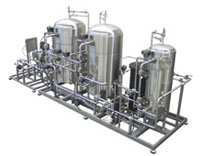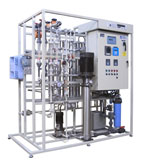Steam Quality.
A continuous supply of saturated steam is required for steam sterilization and for humidification in certain EO sterilizers. Too high a level of non condensible gases will prevent the attainment of sterilization; too little moisture carried in suspension may allow the steam to become superheated during expansion into the chamber, while excess moisture may cause damp loads. Where steam systems are either routinely or irregularly shut down, large quantities of air will be present in the distribution system on restarting. It is recommended that in such circumstances a comprehensive and validated venting procedure should be applied and testing for steam quality is appropriate.
A continuous supply of saturated steam is required for steam sterilization and for humidification in certain EO sterilizers. Too high a level of non condensible gases will prevent the attainment of sterilization; too little moisture carried in suspension may allow the steam to become superheated during expansion into the chamber, while excess moisture may cause damp loads. Where steam systems are either routinely or irregularly shut down, large quantities of air will be present in the distribution system on restarting. It is recommended that in such circumstances a comprehensive and validated venting procedure should be applied and testing for steam quality is appropriate.
Non-condensible gases
Non-condensible gases result from the water from which the steam is generated. These gases will usually be air, though carbon dioxide may be present, caused by certain water treatment processes, typically water softeners. This is exacerbated by excessive aeration that can exist in many pharmaceutical water treatment plants where water is constantly recirculated and sprayed into the top of storage vessels. The effect of such gases being present in the steam supply to a sterilizer can be the same as air, none sterilization of the volume they occupy.
 Superheated steam.
Superheated steam.Superheated steam is steam at a temperature above its boiling point for its pressure. Superheated steam is a clear colour-less gas that will not condense until its temperature drops to its boiling point. Until this occurs the moisture necessary for sterilization cannot be produced and therefore presents a risk to the process. Superheated steam acts as hot air and requires sustained high temperatures and long hold times before sterilization can occur.
 Dryness Value Test.
Dryness Value Test.Wet steam is undesirable as it has less energy than dry steam and more importantly can cause wet loads. The packaging used for sterile products prevents reinfection when dry, but its bacterial retentive properties will be adversely affected by the presence of moisture. Wet loads can be considered to be un-sterile. The dryness fraction describes how dry steam is, with a value of 1 representing steam that is 100% dry, and therefore free of entrained moisture. Steam with a dryness fraction of 0.99 consists of 99% steam and 1% water. If we measure the latent heat present in steam that has a dryness fraction of 0.99 we will find that it possesses 99% of the full quotient of latent heat.
Bring Pure Steam Testing In House.
The draw back to carrying out steam quality testing has always been the lack of the correct Pitot and Expansion Tubes, along with difficulty of generating a quality protocol for qualification purposes. Now these excuses are gone, a quantity of the tubes have been manufactured to a tried and tested design, and are now in stock. The Pure Steam Quality protocol is also available for direct download. This document is not a template, it is a finished document. There is a prefixed SOP which will auto populate the document for you, with your company’s names and addresses, other than that the document is ready to execute.

2 comments:
Great article!
If you're looking for help with steam quality testing, please contact us at Thermal Compliance or visit our web page http://www.thermalcompliance.co.uk/steamqualitytesting.html
Post a Comment